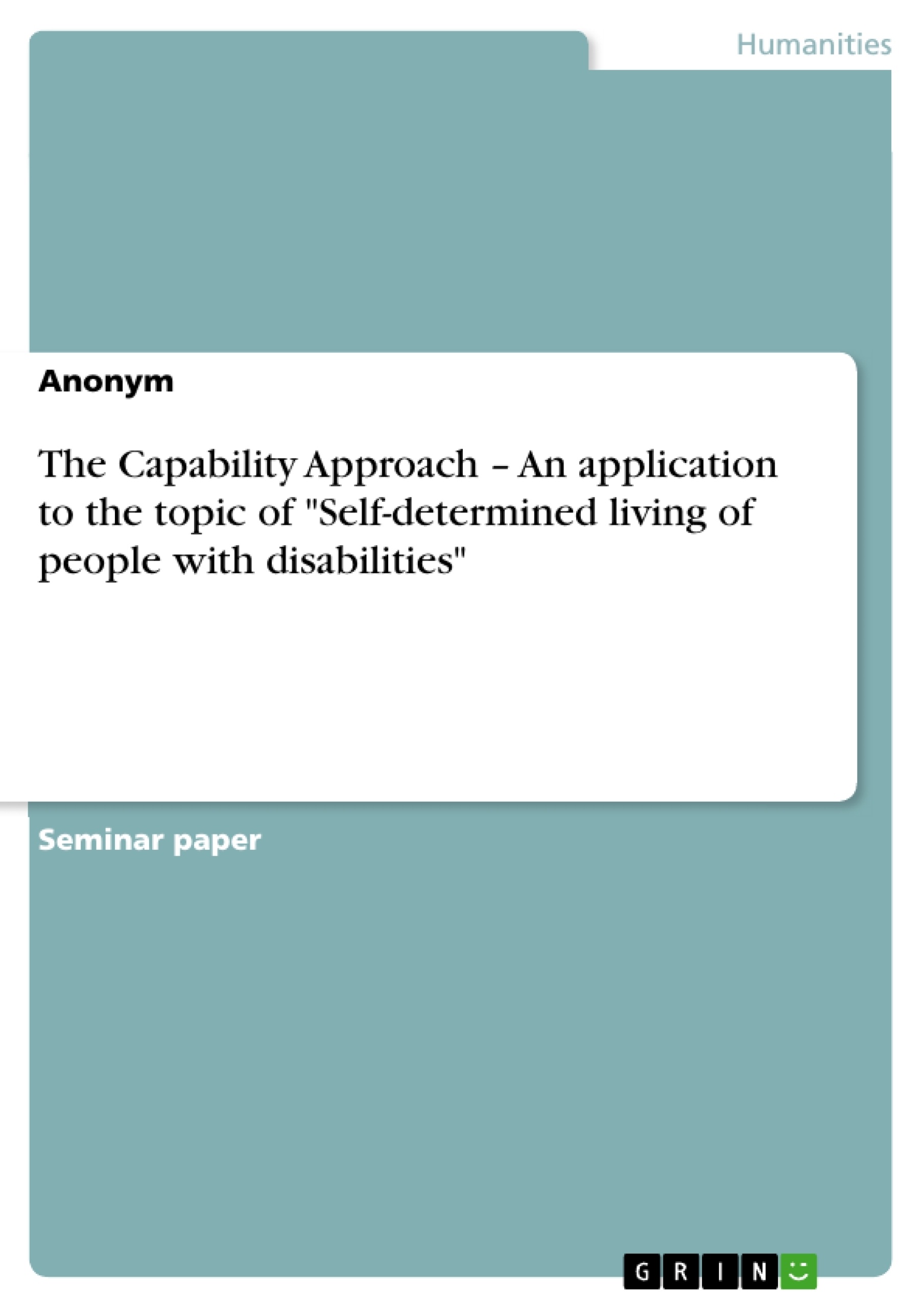The capability approach is about creating justice by enabling people to live a self-determined life. Is this theory suitable to enable people with disabilities to freely choose their housing options? This will be investigated in this paper.
It seemed important to clarify which theories of norm ethics the capability approach is based on and from which it distinguishes itself.
For the majority of the German population, self-determination has been taken for granted since childhood. This circumstance is probably due in particular to the stable democracy. Adults can decide relatively freely about work, leisure, living, partnership and finances. Of course, there are limits to each person's freedom of choice insofar as they come up against the limits of other people, or the financial or cognitive limits of their own person. In comparison, people with disabilities face more limits and external regulations. A large part of those affected cannot freely choose their workplace, but have to come to terms with what is offered.
Many do not have the possibility to decide freely where and with whom they want to live. They also have to experience that partnerships and sexuality are prevented. Free time, the day, meals are planned and "pocket money" is allocated. Then there are the personal cognitive, mental or physical impairments that have to be compensated. The housing wishes of people with disabilities can usually only be implemented to the extent that there are vacancies, for example, in the residential home and in the residential group, or the need for support is rather low, so that outpatient residential care comes into question, or the relatives have enough resources to maintain the care. Most living arrangements involve a relatively high degree of dependence on other people by those affected. But to be dependent is to be externally determined. Innovative model projects for self-determined living are increasingly presented in professional journals. Can people with disabilities live self-determined lives?
Inhaltsverzeichnis (Table of Contents)
- Introduction
- I. Basics of Aristotelian theory in relation to the Capability Approach
- II. Three Dimensions of Meaning of Justice
- III. Ethics of standards
- a. Utilitarianism
- b. Contract theories
- c. Theories of justice
- d. John Rawls Theory of Justice
- IV. The Capability Approach
- a. Capability Approach according to Amartya Sen
- b. Capabilities Approach according to Martha Nussbaum
- V. Criticism of the Capability Approach
- VI. Social work and empowerment justice
- VII. Digression: Self-determined living of people with disabilities in the context of capabilities
- a. Disability/Impairment
- b. Self-determination in case of impairment
- c. Living with disabilities
- VIII. Conclusion
- IX. Bibliography
Zielsetzung und Themenschwerpunkte (Objectives and Key Themes)
This term paper examines the applicability of the Capability Approach to the concept of self-determined living for people with disabilities. It seeks to investigate whether this theory can empower individuals with disabilities to make free choices regarding their living arrangements. The paper begins by clarifying the philosophical underpinnings of the Capability Approach, drawing connections to Aristotelian practical philosophy and theories of justice.
- The philosophical origins of the Capability Approach and its relationship to Aristotelian thought.
- The different dimensions of justice, including legal justice, performance equality, and distributive justice.
- The core principles of the Capability Approach as articulated by Amartya Sen and Martha Nussbaum.
- The application of the Capability Approach to promote self-determined living for people with disabilities.
- Critical analysis of the Capability Approach and its limitations in addressing the challenges faced by people with disabilities.
Zusammenfassung der Kapitel (Chapter Summaries)
- Introduction: This section introduces the topic of self-determined living for people with disabilities and raises the question of whether the Capability Approach can provide a framework for achieving this goal.
- I. Basics of Aristotelian theory in relation to the Capability Approach: This chapter explores the connection between the Capability Approach and the philosophical principles of Aristotle, emphasizing the importance of reason, virtue, and happiness in achieving a good life.
- II. Three Dimensions of Meaning of Justice: This chapter examines the different dimensions of justice, tracing their historical evolution and highlighting the importance of legal equality, performance equality, and distributive justice in promoting social fairness.
- III. Ethics of standards: This chapter discusses various ethical theories that inform the Capability Approach, including utilitarianism, contract theories, and theories of justice, focusing on the ideas of John Rawls.
- IV. The Capability Approach: This chapter provides a comprehensive overview of the Capability Approach, examining the perspectives of Amartya Sen and Martha Nussbaum, and exploring its core principles of individual agency and empowerment.
- V. Criticism of the Capability Approach: This chapter critically examines the limitations and challenges of the Capability Approach, including its potential for overlooking specific needs and vulnerabilities of individuals with disabilities.
- VI. Social work and empowerment justice: This chapter discusses the role of social work in promoting empowerment justice, focusing on how social workers can utilize the principles of the Capability Approach to support self-determined living for people with disabilities.
- VII. Digression: Self-determined living of people with disabilities in the context of capabilities: This chapter delves into the practical application of the Capability Approach to the challenges faced by people with disabilities, exploring issues such as disability, self-determination, and living with disabilities in relation to the theory.
Schlüsselwörter (Keywords)
This term paper focuses on the Capability Approach, its philosophical roots in Aristotelian thought, and its relevance to promoting self-determined living for people with disabilities. Key concepts include justice, empowerment, self-determination, disability, and social work.
- Quote paper
- Anonym (Author), 2015, The Capability Approach – An application to the topic of "Self-determined living of people with disabilities", Munich, GRIN Verlag, https://www.grin.com/document/1190318



